Post-Annealing Effects on the Structure and Semiconductor Performance of Nanocrystalline ZnTe Thin Films Electrodeposited from an Aqueous Solution Containing Citric Acid
Abstract
:1. Introduction
2. Materials and Methods
3. Results and Discussion
3.1. Electrochemical Reduction Behavior of ZnTe from an Aqueous Solution
3.2. Structure of ZnTe Electrodeposited on ITO
3.3. Band Gap Energy and Resistance of Electrodeposited Zinc Telluride
3.4. Electrodeposition of ZnTe Nanowires Array into Nanochannel Templates
4. Conclusions
Author Contributions
Funding
Institutional Review Board Statement
Informed Consent Statement
Data Availability Statement
Acknowledgments
Conflicts of Interest
References
- Pal, U.; Saha, S.; Chaudhuri, A.K.; Rao, V.V.; Banerjee, H.D. Some optical properties of evaporated zinc telluride films. J. Phys. D Appl. Phys. 1989, 22, 965–970. [Google Scholar] [CrossRef]
- Zarei, R.; Ehsani, M.H.; Rezaghiolipour Dizaji, H. An investigation on structural and optical properties of nanocolumnar ZnTe thin films grown by glancing angle technique. Mater. Res. Express 2020, 7, 026419. [Google Scholar] [CrossRef]
- Bellakhder, H.; Outzourhit, A.; Ameziane, E.L. Study of ZnTe thin films deposited by r.f. sputtering. Thin Solid Films 2001, 382, 30–33. [Google Scholar] [CrossRef]
- Wolf, K.; Stanzl, H.; Naumov, A.; Wagner, H.P.; Kuhn, W.; Kahn, B.; Gebhardt, W. Growth and doping of ZnTe and ZnSe epilayers with metalorganic vapour phase epitaxy. J. Cryst. Growth 1994, 138, 412–417. [Google Scholar] [CrossRef]
- Chaure, N.B.; Nair, J.P.; Jayakrishnan, R.; Ganesan, V.; Pandey, R.K. Effect of Cu-doping on the morphology of ZnTe films electrodeposited from nonaqueous bath. Thin Solid Films 1998, 324, 78–84. [Google Scholar] [CrossRef]
- Heo, P.; Ichino, R.; Okido, M. ZnTe electrodeposition from organic solvents. Electrochim. Acta 2006, 51, 6325–6330. [Google Scholar] [CrossRef]
- Islam, A.B.M.O.; Chaure, N.B.; Wellings, J.; Tolan, G.; Dharmadasa, I.M. Development of electrodeposited ZnTe layers as window materials in ZnTe/CdTe/CdHgTe multi-layer solar cells. Mater. Character. 2009, 60, 160–163. [Google Scholar] [CrossRef]
- Hossain, M.I.; Kamruzzaman, M.; Islam, A.B.M.O. Effects of temperature in electrodeposition of ZnTe thin films. J. Mater. Sci. Mater. Electron. 2015, 26, 1756–1762. [Google Scholar] [CrossRef]
- Chaure, N.B.; Chaure, S.; Pandey, R.K. Investigation on the effect of Cu-doping to ZnTe layers by low-cost electrochemical approach. J. Mater. Sci. Mater. Electron. 2017, 28, 11823–11831. [Google Scholar] [CrossRef]
- Basol, B.M.; Kapur, V.K. Preparation of ZnTe thin films using a simple two-stage process. Thin Solid Films 1988, 165, 237–241. [Google Scholar] [CrossRef]
- Mishra, K.K.; Rajeshwar, K. A re-examination of the mechanisms of electrodeposition of CdX and ZnX (X = Se, Te) semiconductors by the cyclic photovoltammetric technique. J. Electroanal. Chem. 1989, 273, 169–182. [Google Scholar] [CrossRef]
- Kashyout, A.B.; Arico, A.S.; Antonucci, P.L.; Mohamed, F.A.; Antonucci, V. Influence of annealing temperature on the opto-electronic characteristics of ZnTe electrodeposited semiconductors. Mater. Chem. Phys. 1997, 51, 130–134. [Google Scholar] [CrossRef]
- Bozzini, B.; Baker, M.A.; Cavallotti, P.L.; Cerri, E.; Lenardi, C. Electrodeposition of ZnTe for photovoltaic cells. Thin Solid Films 2000, 361–362, 388–395. [Google Scholar] [CrossRef]
- Bozzini, B.; Lenardi, C.; Lovergine, N. Electrodeposition of stoichiometric polycrystalline ZnTe on n+-GaAs and Ni-P. Mater. Chem. Phys. 2000, 66, 219–228. [Google Scholar] [CrossRef]
- Mahalingam, T.; John, V.S.; Rajendran, S.; Ravi, G.; Sebastian, P.J. Annealing studies of electrodeposited zinc telluride thin films. Surf. Coat. Technol. 2002, 155, 245–249. [Google Scholar] [CrossRef]
- Rakhshani, A.E.; Pradeep, B. Thin films of ZnTe electrodeposited on stainless steel. Appl. Phys. A 2004, 79, 2021–2025. [Google Scholar] [CrossRef]
- Murali, K.R.; Rajkumar, P.R. Characteristics of pulse plated ZnTe films. J. Mater. Sci. Mater. Electron. 2006, 17, 393–396. [Google Scholar] [CrossRef]
- Liu, Y.; Zhang, X.; Liu, R.; Yang, R.; Liu, C.; Cai, Q. Fabrication and photocatalytic activity of high-efficiency visible-light-responsive photocatalyst ZnTe/TiO2 nanotube arrays. J. Solid State Chem. 2011, 184, 684–689. [Google Scholar] [CrossRef]
- Mahalingam, T.; Dhanasekaran, V.; Sundaram, K.; Kathalingam, A.; Rhee, J.K. Characterization of electroplated ZnTe coatings. Ionics 2012, 18, 299–306. [Google Scholar] [CrossRef]
- Skhouni, O.; ElManouni, A.; Mollar, M.; Schrebler, R.; Marí, B. ZnTe thin films grown by electrodeposition technique on Fluorine Tin Oxide substrates. Thin Solid Films 2014, 564, 195–200. [Google Scholar] [CrossRef]
- Kim, D.; Park, K.; Lee, S.; Yoo, B. Electrochemical synthesis of ZnTe thin films from citrate bath and their electrical properties with incorporation of Cu. Mater. Chem. Phys. 2016, 179, 10–16. [Google Scholar] [CrossRef]
- Hossain, M.I.; Siddiquee, K.A.M.H.; Islam, O.; Gafur, M.A.; Qadir, M.R.; Ahmed, N.A. Characterization of electrodeposited ZnTe thin films. J. Opt. 2019, 48, 295–301. [Google Scholar] [CrossRef]
- Bouroushian, M.; Kosanovic, T.; Karoussos, D.; Spyrellis, N. Electrodeposition of polycrystalline ZnTe from simple and citrate-complexed acidic aqueous solutions. Electrochim. Acta 2009, 54, 2522–2528. [Google Scholar] [CrossRef]
- Neumann-Spallart, M.; Königstein, C. Electrodeposition of zinc telluride. Thin Solid Films 1995, 265, 33–39. [Google Scholar] [CrossRef]
- Ohgai, T.; Washio, R.; Tanaka, Y. Anisotropic Magnetization Behavior of Electrodeposited Nanocrystalline Ni-Mo Alloy Thin Films and Nanowires Array. J. Electrochem. Soc. 2012, 159, H800–H804. [Google Scholar] [CrossRef] [Green Version]
- Ohgai, T.; Fujimaru, T.; Tanaka, Y. Isotropic magnetization response of electrodeposited nanocrystalline Ni–W alloy nanowire arrays. J. Appl. Electrochem. 2014, 44, 301–307. [Google Scholar] [CrossRef] [Green Version]
- Saeki, R.; Ohgai, T. Perpendicular magnetization performance of hcp-cobalt nanocylinder array films electrodeposited from an aqueous solution containing cobalt (II)–citrate complexes. J. Mater. Res. Technol. 2020, 9, 8029–8040. [Google Scholar] [CrossRef]
- Ishizaki, T.; Ohtomo, T.; Sakamoto, Y.; Fuwa, A. Effect of pH on the Electrodeposition of ZnTe Film from a Citric Acid Solution. Mater. Trans. 2004, 45, 277–280. [Google Scholar] [CrossRef] [Green Version]
- Nakano, H.; Ohgai, T.; Fukushima, H.; Akiyama, T.; Kammel, R. Factors Determining the Critical Current Density for Zinc Deposition in Sulfate Solutions. Metall 2001, 55, 676–681. [Google Scholar]
- Ishizaki, T.; Saito, N.; Takai, O.; Asakura, S.; Goto, K.; Fuwa, A. An investigation into the effect of ionic species on the formation of ZnTe from a citric acid electrolyte. Electrochim. Acta 2005, 50, 3509–3516. [Google Scholar] [CrossRef]
- Lin, M.C.; Chen, P.Y.; Sun, I.W. Electrodeposition of Zinc Telluride from a Zinc Chloride-1-Ethyl-3-methylimidazolium Chloride Molten Salt. J. Electrochem. Soc. 2001, 148, C653–C658. [Google Scholar] [CrossRef]
- Gandhi, T.; Raja, K.S.; Misra, M. Synthesis of ZnTe nanowires onto TiO2 nanotubular arrays by pulse-reverse electrodeposition. Thin Solid Films 2009, 517, 4527–4533. [Google Scholar] [CrossRef]
- Martin, C.R. Template synthesis of polymeric and metal microtubules. Adv. Mater. 1991, 3, 457–459. [Google Scholar] [CrossRef]
- Ohgai, T.; Mizumoto, M.; Nomura, S.; Kagawa, A. Electrochemical Fabrication of Metallic Nanowires and Metal Oxide na-Nopores. Mater. Manuf. Process. 2007, 22, 440–443. [Google Scholar] [CrossRef] [Green Version]
- Ohgai, T.; Hjort, K.; Spohr, R.; Neumann, R. Electrodeposition of cobalt based ferro-magnetic metal nanowires in polycarbonate films with cylindrical nanochannels fabricated by heavy-ion-track etching. J. Appl. Electrochem. 2008, 38, 713–719. [Google Scholar] [CrossRef] [Green Version]
- Piraux, L. Magnetic Nanowires. Appl. Sci. 2020, 10, 1832. [Google Scholar] [CrossRef] [Green Version]
- Neetzel, C.; Ohgai, T.; Yanai, T.; Nakano, M.; Fukunaga, H. Uniaxial magnetization performance of textured Fe nanowire arrays electrodeposited by a pulsed potential deposition technique. Nanoscale Res. Lett. 2017, 12, 598. [Google Scholar] [CrossRef]
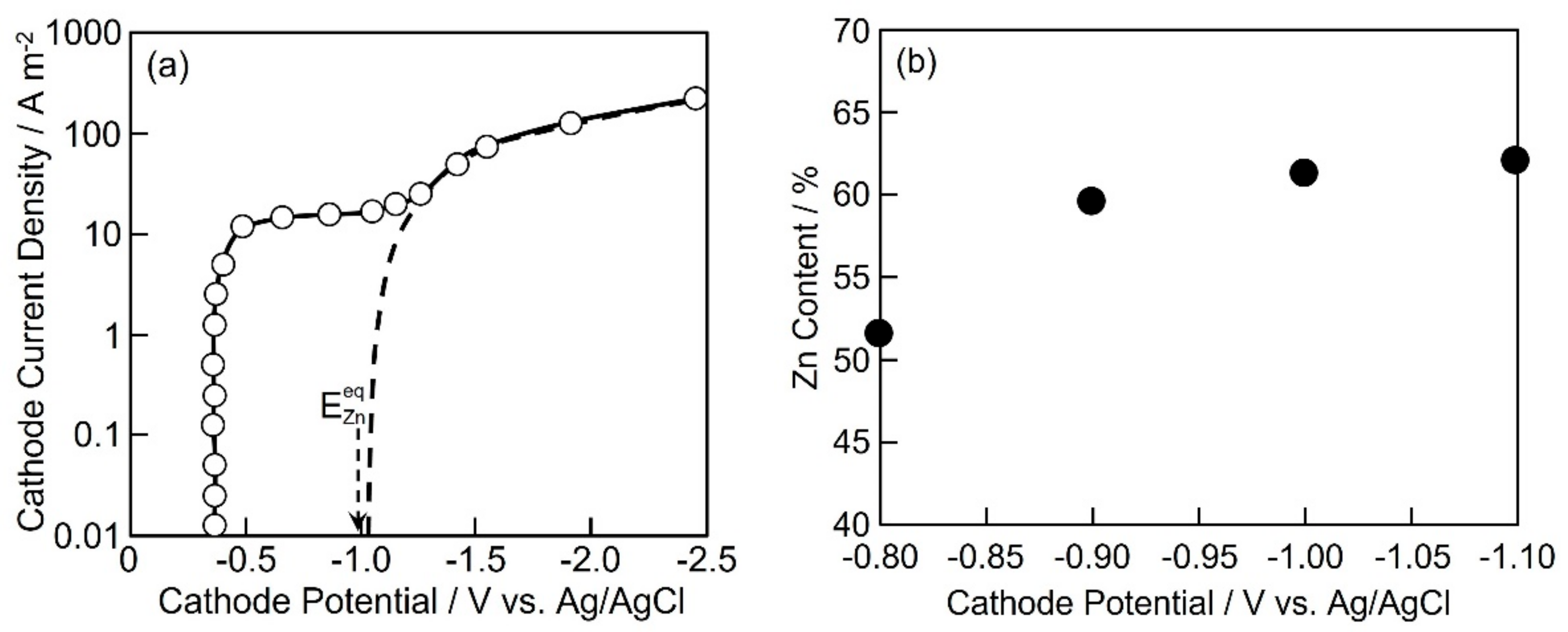

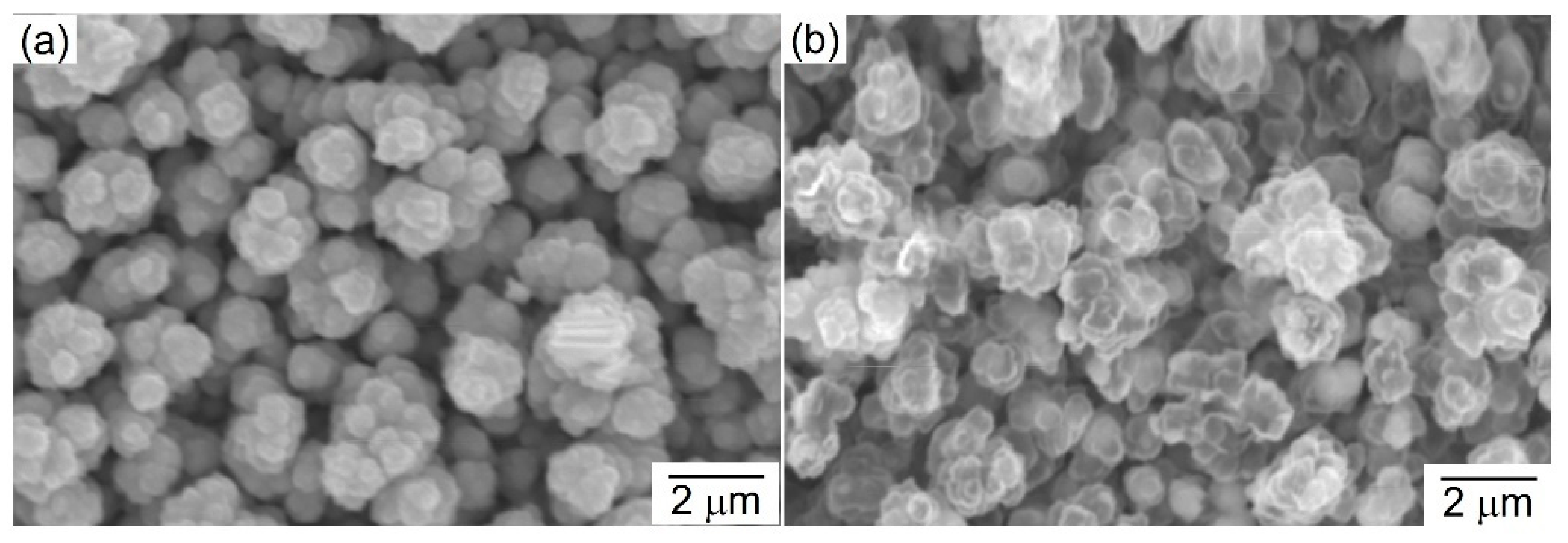
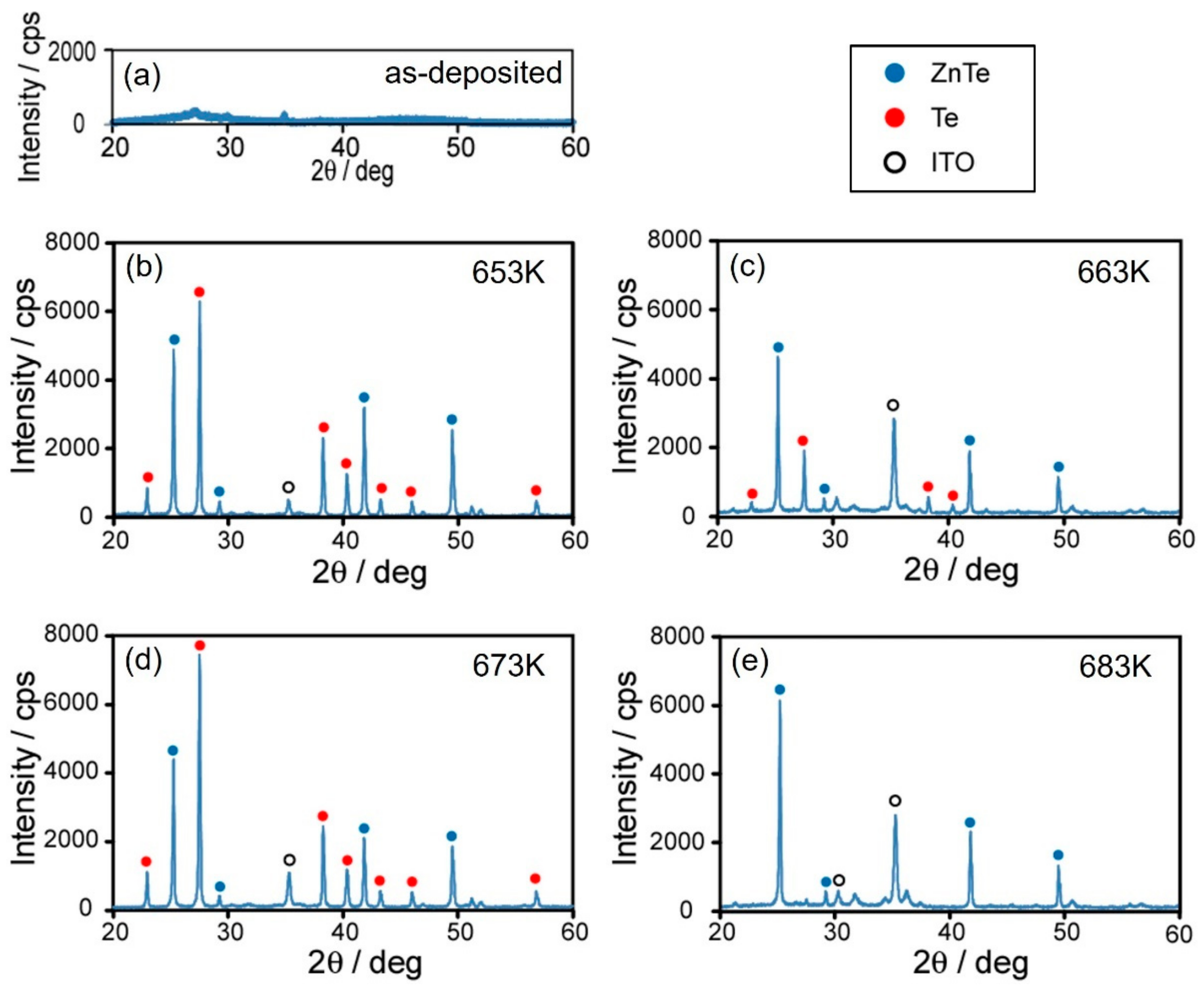
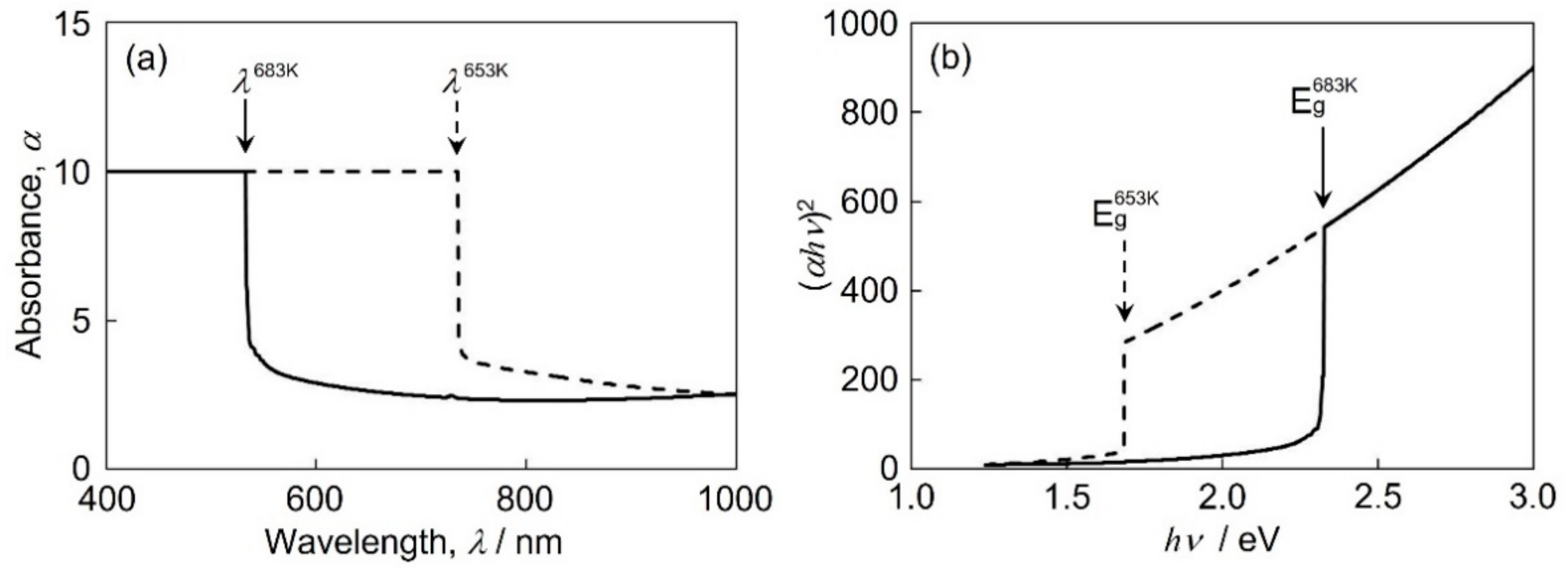
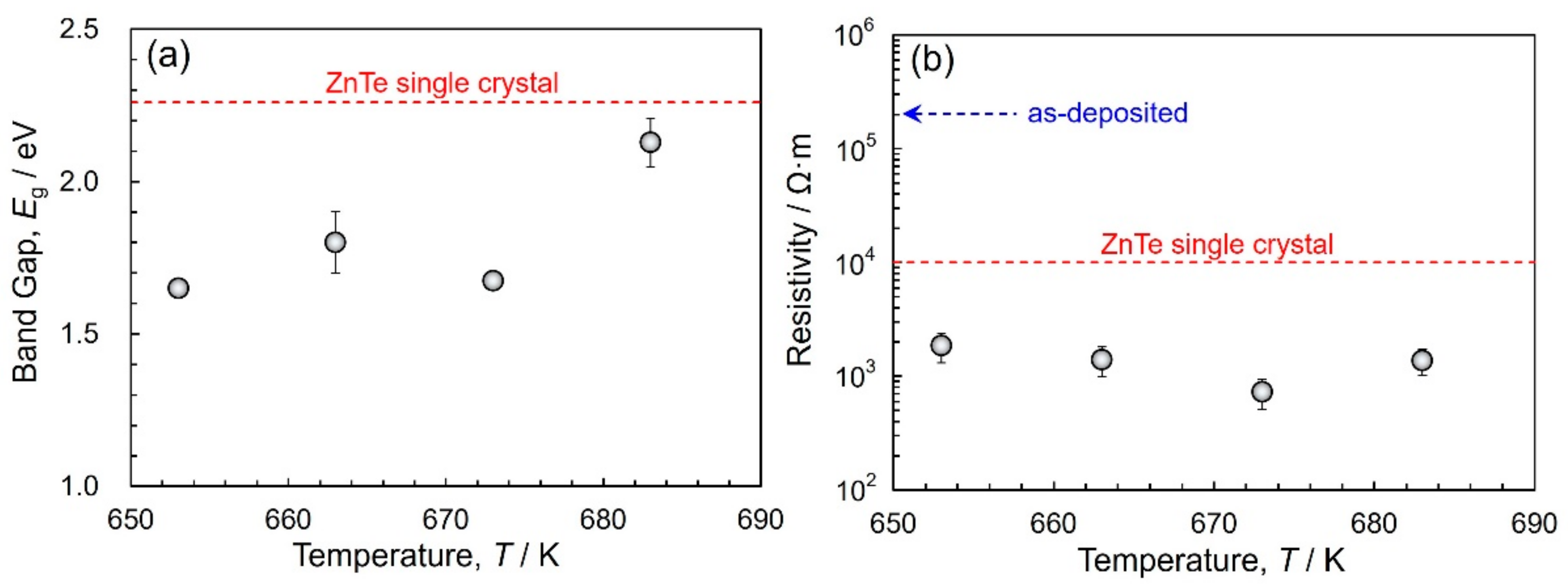
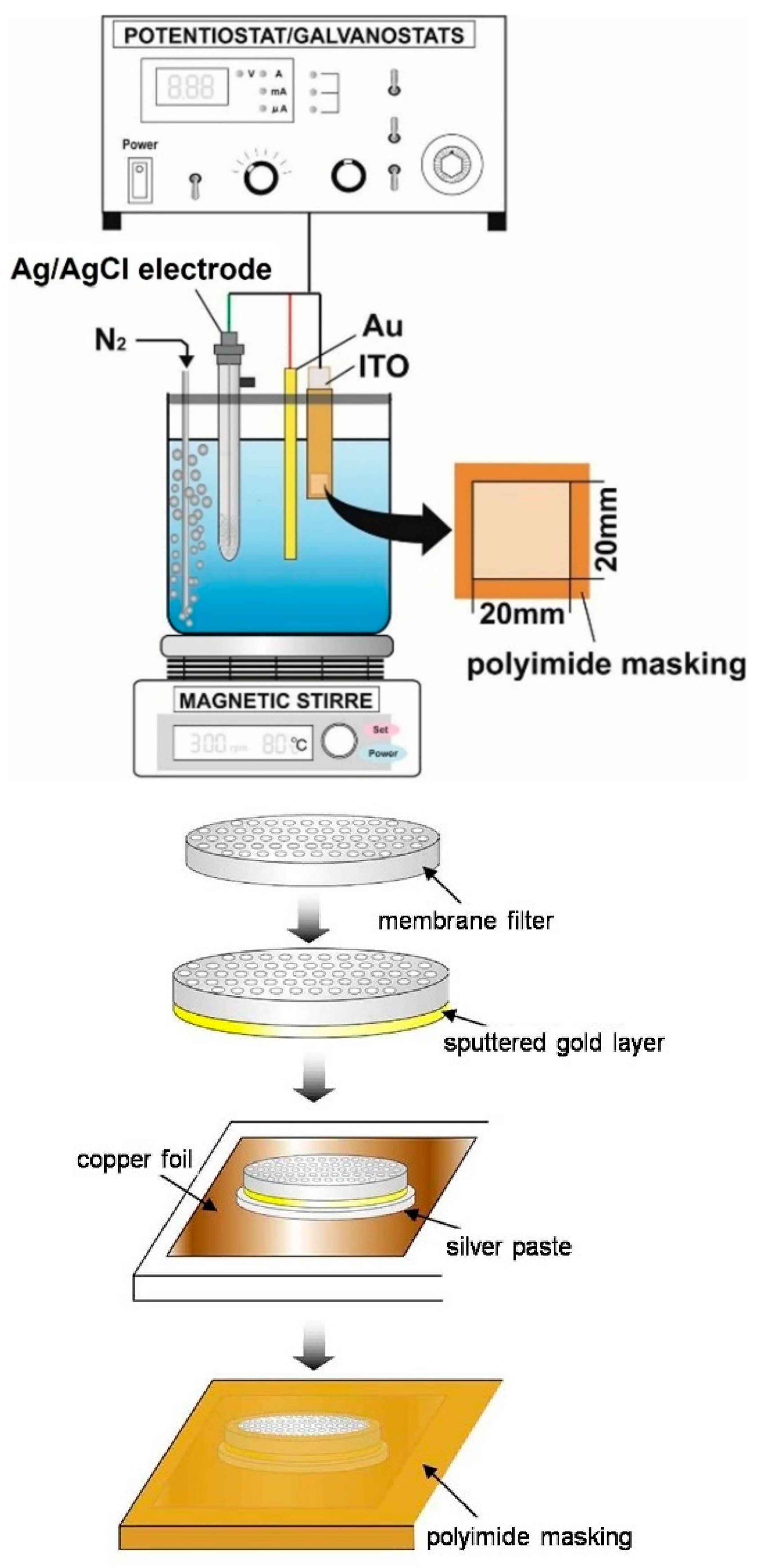
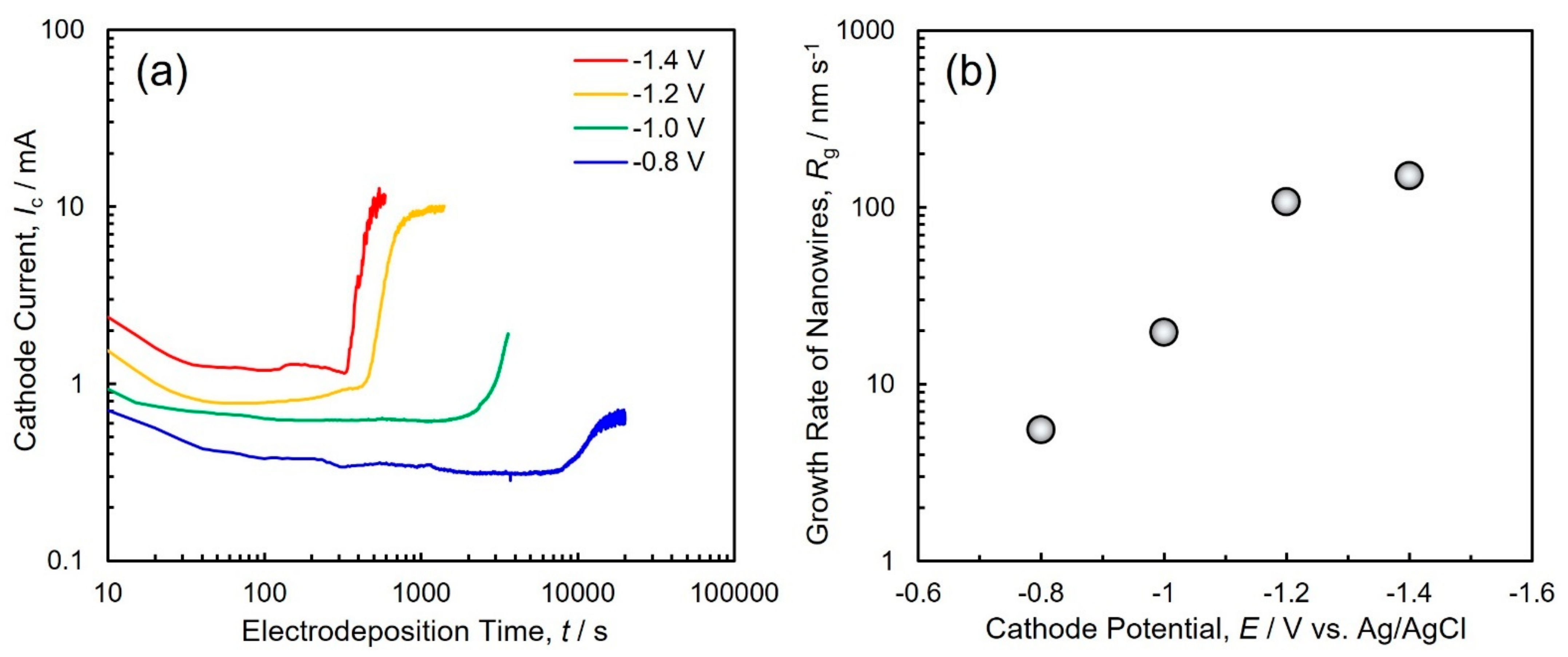

Publisher’s Note: MDPI stays neutral with regard to jurisdictional claims in published maps and institutional affiliations. |
© 2021 by the authors. Licensee MDPI, Basel, Switzerland. This article is an open access article distributed under the terms and conditions of the Creative Commons Attribution (CC BY) license (https://creativecommons.org/licenses/by/4.0/).
Share and Cite
Ohta, J.; Ohgai, T. Post-Annealing Effects on the Structure and Semiconductor Performance of Nanocrystalline ZnTe Thin Films Electrodeposited from an Aqueous Solution Containing Citric Acid. Appl. Sci. 2021, 11, 10632. https://doi.org/10.3390/app112210632
Ohta J, Ohgai T. Post-Annealing Effects on the Structure and Semiconductor Performance of Nanocrystalline ZnTe Thin Films Electrodeposited from an Aqueous Solution Containing Citric Acid. Applied Sciences. 2021; 11(22):10632. https://doi.org/10.3390/app112210632
Chicago/Turabian StyleOhta, Jun, and Takeshi Ohgai. 2021. "Post-Annealing Effects on the Structure and Semiconductor Performance of Nanocrystalline ZnTe Thin Films Electrodeposited from an Aqueous Solution Containing Citric Acid" Applied Sciences 11, no. 22: 10632. https://doi.org/10.3390/app112210632
APA StyleOhta, J., & Ohgai, T. (2021). Post-Annealing Effects on the Structure and Semiconductor Performance of Nanocrystalline ZnTe Thin Films Electrodeposited from an Aqueous Solution Containing Citric Acid. Applied Sciences, 11(22), 10632. https://doi.org/10.3390/app112210632





